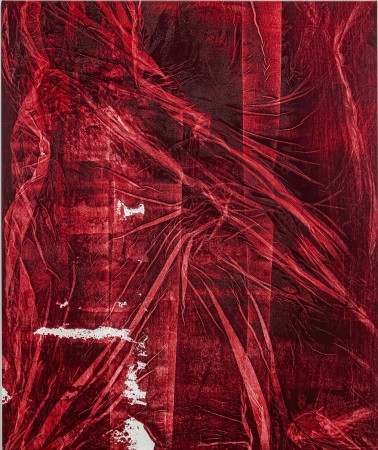8 April to 17 July 2021

Notes on Shirley Wiitasalo’s transfer paintings
1.
The variability and nuance of texture coheres as individual monochromatic compositions. A series of autonomous works that when viewed together are balanced in terms of color and form.
2.
What is autonomy? Sailing/failing, facilitating accidental encounters with matter, organizing chaos to speak of an underlying design? Autonomy has no program; it is just sheer vibrant matter.
3.
The opaque whiteness counters the illusionistic screen; a surface that emanates nothings that burst with a history of empty metaphors; compositions filled with the scratching, coughing moments of the room.
4.
The white ground of these paintings is a surface that is at once both present and absent. It is muted by the delicate transferred layer that sit on top, but also sets up the possibility of infinite space somewhere beyond the illusion of paint. The transferred layer floats on top of the ground, is activated by it but veils it.
5.
The contingency of transferring materials results in the possibility of multiple variables. To transfer is the process of movement between one surface/subject to another, this exchange imprints itself on the other, never conforming to an exact system but rather registering the incertitude of becoming, an effervescent process in motion.
6.
Surface resides in the room but the screen is the eye of the nervous system.
7.
The screen flickers with an elusive subject matter that hints towards an experience of ruffled linens, crinkled plastic, or creases of skin. Perhaps this simultaneity of folds is at once both visceral and theoretical; evoking a multiplicity of associations. These paintings don’t translate through language but through body; a familiarity, a prehension, that evades the tangible.
8.
An affect that is fleeting, contingent, but concretely and sweetly of the body.
9.
Paint is a radically passive communicator that when employed for its formal ingenuity, points magically in the direction of interiority, calling for a recalling of surfaces once seen, tasted, and touched.
10.
When process becomes subject the subject emerges as the articulation of “mute sensation”.
11.
Sensibility is the intelligence of the body to know that which is not reducible to information. As Franco “Bifo” Berardi notes “Like a thin film, sensibility makes it possible for human beings to conjoin and enter empathic relations, or in other words, to ‘regress’ to a non-specified and non-codified state of a body without organs that pulsate in unison.
12.
Painting is the process of ordering accident, an index of chance. But accidents do seem to be the registering of intention. Perhaps all intention is just the ordering of accidents; a theoretical structuring for contingencies? Beyond, and within these folds of order is the whirling potentiality of chaos and these paintings seem to be the material investigation of such theoretical spaces.

